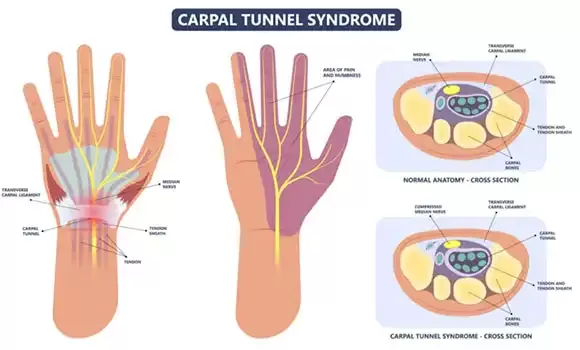Comprehensive Treatment Approaches to Hand Numbness at Wimbledon Chiro & Sports Injury Clinic

Hand numbness, commonly attributed to Carpal Tunnel Syndrome (CTS), often stems from various underlying causes that must be identified and addressed for effective treatment.
At Wimbledon Chiro & Sports Injury Clinic, we offer a detailed and multifaceted approach to diagnosing and treating these conditions. We recognise that symptoms can result from multiple sites of nerve compression. Having a practitioner who is looking at all sites on nerve impingement and isn't just exploring to confirm carpal tunnel typically will lead to better diagnosis and potentially avoid the need for surgical intervention
True Carpal Tunnel Syndrome vs. Double Crush Syndrome
True Carpal Tunnel Syndrome (CTS) involves the median nerve compression within the carpal tunnel at the wrist. Symptoms include numbness, tingling, and weakness, primarily affecting the thumb, index, and middle fingers. Repetitive hand movements, wrist injuries, and conditions like arthritis are common causes.
Double Crush Syndrome occurs when the median nerve is compressed at two or more locations along its path. This secondary compression often happens in the cervical spine or thoracic outlet, exacerbating the symptoms and making them more persistent and severe.

Occupational Stress and Postural Syndromes
Many patients, particularly those who spend long hours at a computer, suffer from a combination of CTS and Double Crush Syndrome due to poor posture, specifically Upper Cross Syndrome. This postural imbalance leads to tight and overactive neck, shoulders, and chest muscles and weak and underactive muscles in the upper back and neck. This imbalance can cause poor neck and shoulder positioning, contributing to nerve compression at multiple sites.
Addressing Postural Issues
Proper work ergonomics are crucial in mitigating these conditions. At our clinic, we focus on:
- Adjusting Desk Height and Chair Position: Ensuring that the computer screen is at eye level and the chair supports proper posture.
- Regular Breaks and Stretching Exercises: Incorporating stretches and movements to alleviate muscle tension and prevent nerve compression.
- Strengthening and Flexibility Exercises: Targeting the upper back, neck, and shoulder muscles to correct imbalances associated with Upper Cross Syndrome.
Cubital Tunnel Syndrome and Thoracic Outlet Syndrome
Cubital Tunnel Syndrome involves the compression of the ulnar nerve at the elbow, causing numbness and tingling in the ring and little fingers. This condition can mimic or exacerbate CTS symptoms. Factors such as prolonged elbow flexion or pressure on the elbow can contribute to this syndrome.
Thoracic Outlet Syndrome (TOS) occurs when nerves or blood vessels between the collarbone and first rib (thoracic outlet) are compressed. This can cause shoulder and neck pain and numbness in the fingers. Precrush elements in TOS include:
- Pectoralis Minor Entrapment: Tightness or hypertrophy of the pectoralis minor muscle can compress the neurovascular bundle.
- Scalene Muscle Entrapment: Hypertrophy or tightness in the scalene muscles can compress the brachial plexus.
- Cervical Disc Issues or Bony Stenosis: Degenerative changes or congenital anomalies in the cervical spine can lead to nerve compression, contributing to TOS.
Pronator Teres Syndrome and Anterior Interosseous Nerve Syndrome
Pronator Teres Syndrome (PTS) involves compression of the median nerve in the forearm, resulting in sensory alterations in the median nerve distribution of the hand and the palmar cutaneous distribution of the thenar eminence/thumb pad. Symptoms include pain and numbness in the forearm and hand, often exacerbated by repetitive pronation and supination of the forearm.
Anterior Interosseous Nerve Syndrome (AINS) is characterised by complete or partial loss of motor function of the muscles innervated by the anterior interosseous nerve, a motor branch of the median nerve in the forearm. Patients may experience weakness in the flexor pollicis longus and the flexor digitorum profundus of the index finger, affecting the ability to pinch and grip.
Carpal Tunnel Syndrome in Pregnancy
CTS is common in pregnant women and is often attributed to oedema, which increases pressure within the carpal tunnel. However, another significant factor is the hormone **relaxin**, which loosens ligaments and can lead to habitual wrist positioning that contributes to nerve compression.
Treatment for Pregnant Women
Our clinic provides specialised care for pregnant women experiencing CTS, focusing on:
- Coaching on Wrist Positioning: Educating patients on maintaining neutral wrist positions, especially during activities like breastfeeding.
- Manual Therapy and Gentle Exercises: Reducing tension and improving blood flow to alleviate symptoms.
- Use of Splints: Providing support to maintain proper wrist alignment, particularly during sleep.
Addressing these issues promptly is crucial, as relaxin continues to affect the ligaments while breastfeeding, potentially prolonging discomfort if not managed effectively.
Advanced Treatments for Stubborn Nerve Impingements
We employ advanced treatment techniques for patients with stubborn or chronic nerve impingements to achieve lasting relief and functional improvement.
Wrist Manipulation and Myofascial Techniques
- Wrist Manipulation: This technique helps the carpal tunnel re-arch naturally, relieving pressure on the median nerve.
- Myofascial Release: We use targeted myofascial techniques to release secondary or primary crush sites, reducing muscle tension and improving nerve mobility.
Focused Shock Wave Therapy
Emerging protocols such as **Focused Shock Wave Therapy** are showing remarkable results in challenging cases. This therapy targets scar tissue and associated adhesions that clamp nerves through muscles and aponeurosis, promoting healing and reducing nerve entrapment.
Radiographic and Postural Analysis
We employ a radiographically guided and postural analysis software-led approach to:
- Neck Alignment: Reducing cervical stenosis and recalibrating the scalene muscles that can clamp the nerve plexus.
- Comprehensive Assessment: Identifying all potential compression sites and contributing factors to tailor a precise treatment plan.
Many patients come to us after failed surgical interventions or seeking to avoid surgical downtime. Our non-invasive treatments provide an effective alternative, enabling patients to continue their daily activities without interruption.
Comprehensive Care at Wimbledon Chiro & Sports Injury Clinic
Our multidisciplinary team at Wimbledon Chiro & Sports Injury Clinic provides thorough assessments and tailored treatment plans. We combine chiropractic adjustments, manual therapy, ergonomic advice, and exercise programs to address immediate symptoms and underlying nerve compression causes. Whether dealing with CTS, Double Crush Syndrome, or related conditions, our goal is to restore function, alleviate pain, and improve our patients' overall quality of life.
By taking a holistic approach that considers all potential sources of nerve compression and contributing factors, we ensure effective and long-lasting relief from hand numbness and related symptoms. If you are experiencing symptoms of CTS or any related issues, contact us today to schedule a comprehensive evaluation and start your journey towards recovery.